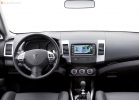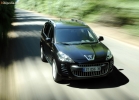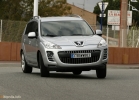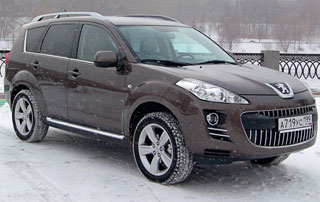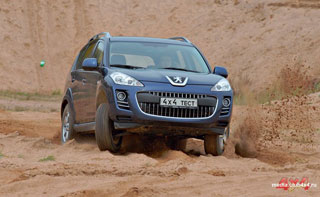PEUGEOT 4007 test drive since 2007 SUV
Reduced game
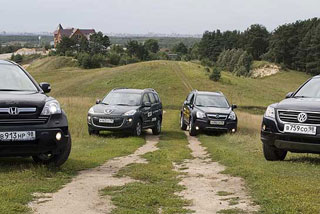 Two or four, two or four, two or four one or four! Most cars have the same engines in volume, and only the Tiguan engine is out of the row. But this does not make him an outsider. On the contrary: his bit around the unit is the latest serial embodiment of engineering thought.
Two or four, two or four, two or four one or four! Most cars have the same engines in volume, and only the Tiguan engine is out of the row. But this does not make him an outsider. On the contrary: his bit around the unit is the latest serial embodiment of engineering thought. Economical dynamics against atmospheric proportionality. Freshness and manufacturability against experience, unification and joint work of transcontinental auto giants. Today, the heroes of the segment of compact crossovers are trying to repulse the new Volkswagen Tiguan.
Opel Antara 2.4 manual transmission
Outside
If you compare the Opel Antara with the CHREVROLET CAPTIVA soplatform brother, then in the form of a German you can see some sports notes of the roof more sloping (there is no need, like in Captiva, to place the third row of seats), more acute bodies of the body, and in general the car looks easier.
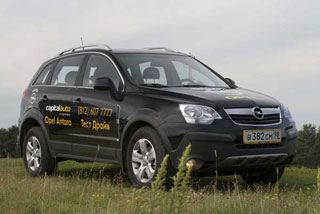 As part of our test, Antara is not able to surprise with an advanced design: unless it seems solid next to the very rustic Tiguan Opel. But classic forms allowed to do without dubious experiments with the inner space of the place and in front, and there are plenty of behind.
As part of our test, Antara is not able to surprise with an advanced design: unless it seems solid next to the very rustic Tiguan Opel. But classic forms allowed to do without dubious experiments with the inner space of the place and in front, and there are plenty of behind. Inside
Inside Opel, it is difficult to confuse with something other corporate identity are followed by all the products of the company: from the baby Corsa to Big Antara. The wedge -shaped medium console made of rough plastic carries classic three climate regulators, three large circle of blowing deflectors and a well -reading information screen.
The devices are even decorated with some aristocracy: large scales of the speedometer and tachometer, which are highlighted in silver rings, look good in themselves, but, alas, they do not compose with the style of restrained techno, in which the rest of the interior is made.
Planting in Opel is slightly overshadowed by the location of the pedal node: it is placed high and, at the same time, drowned deep into it. Because of this, even a tall driver is forced to either lower the seat (which is not great in a high car), or sitting closer to the steering wheel.
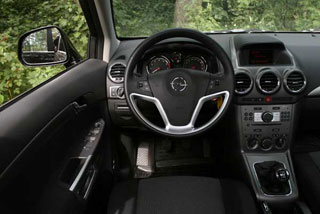 The rest is moderately tough seats only delight, the build quality (Russian, by the way) is quite satisfied. Plastic in the finish is more expensive, to match the price, it would be even better.
The rest is moderately tough seats only delight, the build quality (Russian, by the way) is quite satisfied. Plastic in the finish is more expensive, to match the price, it would be even better. In move
Motor 2.4 with a capacity of 140 liters. with. Not the best option for a crossover with a equipped mass of 1,805 kg. The next in volume the unit with which is offered Antara, already with a volume of 3.2 l with a capacity of 227 liters. S.: For many, this is an explicit overkill in terms of economy, and at the same time an overhead tax.
But the manual box, with which Opel is offered, promises not only to save 40,000 rubles. When buying, but also to disdain a modest herd under the hood.
The main thing that I do not want to put up with movement, weak craving at medium speeds. And this despite the fact that there are as many as two economical gears in the car: the fifth and direct sixth.
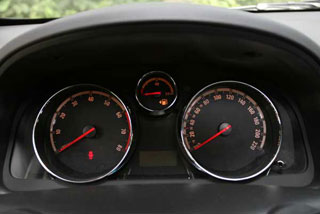 On the highway during a speed of speed after 100 km/h, I had to change the fifth to the fourth, otherwise the speedometer shooter crawled on the scale impermissible slowly. In the city of the motor, quite long gears are quite enough not so often disturbing the IAC lever, and do not lag behind the flow. The only minus at high speeds is noisy.
On the highway during a speed of speed after 100 km/h, I had to change the fifth to the fourth, otherwise the speedometer shooter crawled on the scale impermissible slowly. In the city of the motor, quite long gears are quite enough not so often disturbing the IAC lever, and do not lag behind the flow. The only minus at high speeds is noisy. Outside of the roads, all -wheel drive manifests itself well: unknown, without locks, it allows you to confidently force the blurry sections of the track. The DCS system is designed to help when descending from the mountain, it maintains a constant speed of 10-15 km/h, preventing it from accelerating. Just do not forget that Opel Antara road tires feel much better on the asphalt than outside it.
Total
The price has never been a strong feature of German cars. But the buyer Antara will receive neither innovations nor outstanding design for his money. Another thing is that from our four Opel is offered with the most powerful, 3.2-liter engine for someone this can become a decisive factor. As well as the fact that the waiting period for the ordered car is limited to several weeks.
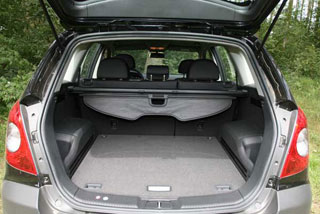 Technical characteristics Opel Antara 2.4 manual transmission
Technical characteristics Opel Antara 2.4 manual transmission (manufacturer data)
Dimensions, mm (DHSHHV)
4 580 x 1 850x 1 704
Equipped mass, kg
1805
Road clearance, mm
200
Trunk volume, l (min)
370
Engine volume and power, l (l.
2.4 (140/5 200)
Maximum torque, Nm at rpm
220/2 400
Acceleration to 100 km/h, with
13.3
Maximum speed, km/h
170
Fuel consumption (city/highway), l/100 km
13.3/14.6
Prices
With a 2.4 engine and manual transmission Opel Antara costs from 897,000 rubles. The same machine, but with an automatic transmission, is already drawn by 937,000 rubles. The equipment of the cars is as follows: ABS, ESP, the stabilization system of the trailer stability (TSP), a permanent all -wheel drive system with an anti -tugal system (TC), a help system for descent in difficult road conditions (DCS), climate control, skin -trimmed steering wheel, six airbags of safety pillows . With an engine 3.2 Antara prices start from 1,095,000 rubles. for the COSMO equipment, and up to 1,205,000 rubles, for Cosmo Premium Plus. The box in this case without options is only an automatic.
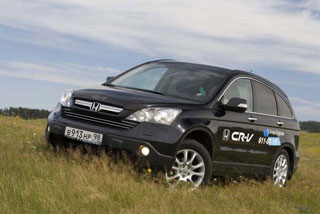 Honda CR-V 2.4
Honda CR-V 2.4 Outside
A narrow line of black grill mouth against the background of a pot -bellied body or a steep upper glazing line that is contrary to a straight roof
Separately, the details of Honda CR-V are in disharmony, but within the framework of one car they look at least interesting. The fashion is now in the way of the appearance of the crossover and the coupe (remember at least the last novelty of the BMW X6), and the Honda designers managed to catch the tendency in the rudiment.
Inside
The Hondians know a lot about sports interiors: in addition, they manage to make them comfortable. The first thing that catches your eye is an air console with a short variator selector. Thus, the landing is as assembled as possible: all the main controls at hand and look towards the driver.
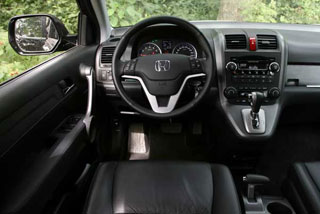 The quality of execution is also on top: in the cabin, soft plastic of different shades and solid skin reigns in the cabin.
The quality of execution is also on top: in the cabin, soft plastic of different shades and solid skin reigns in the cabin. Ergonomics pleased: due to the compact construction of the front panel, niches and cup holders between the front seats were comfortable, and the seats themselves are quite comfortable. I did not like only narrow slippery and rather highly placed armrests on the backs.
In move
The element of Honda CR-V asphalt, preferably even. On the bumps, a car, and at the same time a driver and passengers shakes great, and there is no need to talk about comfortable movement.
On the highway, the picture changes strictly diametrically opposite to the behavior of the car is absolutely passenger. The steering wheel amplifier does not process, making the control itself quite hard and, at the same time, informative.
Turns the machine passes without tangible rolls, allowing to fully fully realize the power of a 2.4-liter motor. And if the same Antara engine of the same volume is basic, then in the case of CR-V this is the most powerful unit. But do not forget: the equipped mass of Honda CR-V is only one and a half tons. For such a power of power of 166 liters. with. Enough enough.
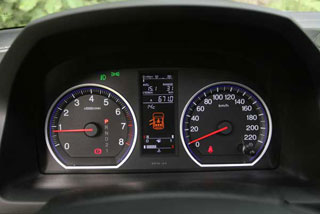 The crossover accelerates rapidly, in sports, and the speed of the boxing box only confirms: for the active driver of the Honda CR-V 2.4, a worthy choice.
The crossover accelerates rapidly, in sports, and the speed of the boxing box only confirms: for the active driver of the Honda CR-V 2.4, a worthy choice. But the modest road clearance means the extra -spal caps of the crossover very limited.
Total
With the advent of a new motor and not without that, the strong positions of CR-V have become even stronger: you can now record not only memorable appearance and cool interior solutions, but also inspiring dynamics in the model’s asset.
In Honda, they did not chase off -roadness and equip the car with a pseudojep package, but focused on the convenience of its operation in the city. Judging by the abundance of orders, many customers value this quality in crossovers.
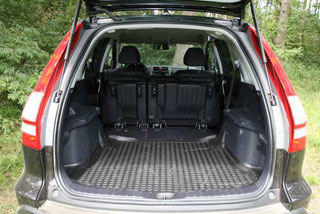 Technical characteristics Honda CR-V 2.4 automatic transmission
Technical characteristics Honda CR-V 2.4 automatic transmission (manufacturer data)
Dimensions, mm (DHSHHV)
4 530 x 1 820 x 1 675
Equipped mass, kg
1 595
Road clearance, mm
175
Trunk volume, l (min)
442
Engine volume and power, l (l.
2.4 (166/5 800)
Maximum torque, Nm at rpm
220/4 200
Acceleration to 100 km/h, with
eleven
Maximum speed, km/h
190
Fuel consumption (city/highway), l/100 km
13.1/7.4
Prices
The most modest CR-V with a 2.0 engine and six-speed mechanics costs 862,000 rubles. Such a machine will be equipped with air conditioning, heated seats, immobilizer, central lock, as well as ABS, EBD, VSA, TSA, and eight (!) Safety pillows. You need to pay 938,000 rubles for a car with automatic transmission. As a bonus, get the decoration with the skin of the selector and the steering wheel, the rain and light sensor, as well as the discs for 17.
With a 2.4 CR-V engine costs 1,049,000 1,079,000 rubles, and only the automatic engineer will no longer choose the box.
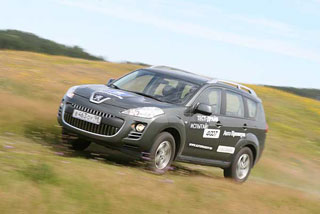 PEUGEOT 4007
PEUGEOT 4007 Outside
Mitsubishi crossover, rested by Peugeot, like Soviet champagne: at first you don’t understand how this can be, but having tried it, you realize that everything could be worse.
The face in the PEUGEOT 308 style, stuck to Mitsubishi Outlander XL, is perceived for the first time, but you also get used to it. Otherwise, the French acceptor repeats the appearance features of its Japanese donor: the same profile and back, side mirrors and even relings.
The neck of the fuel tank is in Japanese on the left. Peegeot owners are unusual, but looking at the appearance of the car, you understand: you can get used to anything
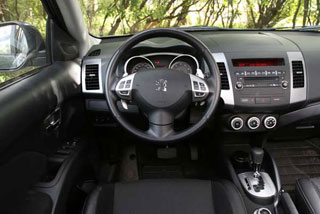 Inside
Inside Unlike interior designers who worked on the Captiva-Entara pair, their French colleagues had at least work. The point in the daily routine development of the interior design, apparently, was perceived as free time.
Almost everything remains from the Outlander salon: spacious dimensions, conveniently compiled tools of the central console, steering wheel switches and even buttons on the steering wheel. The latter, however, is already with French Schilda.
The same rustic instruments from Mitsubishi delight less; However, the development of Peugeot has recently not shine in innovation in the design of the toolbar.
The standard radio tape recorder from the XL sounds great, and at an additional 4007 fee, you can receive a color sensory display. And the Japanese climate control with three rotating circles is easier and more convenient than buttons with an electronic scoreboard, like on the French.
However, the owners of Peugeot most likely have a different point of view. Apparently, they will have to get used to it and
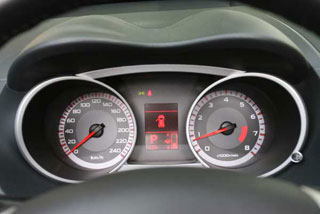 Seats sheathed with skin and fabric are quite comfortable, but lateral support is clearly not enough. Especially compared to the grip chairs of Opel and Volkswagen. The convenience of landing is also reflected in the steering wheel adjustment. But here it is worth making a reservation: this does not affect the convenience of placing a medium -sized driver.
Seats sheathed with skin and fabric are quite comfortable, but lateral support is clearly not enough. Especially compared to the grip chairs of Opel and Volkswagen. The convenience of landing is also reflected in the steering wheel adjustment. But here it is worth making a reservation: this does not affect the convenience of placing a medium -sized driver. In move
PEUGEOT 4007 is controlled well, but this is still not a hatchback.
But the French pendant provided Mitsubishi frame with good smoothness. Both on the asphalt and off -road on Peugeot does not shake and does not rock.
From the whole four, a trick with a glass of water on a torpedo (accelerating without spilling a drop) will be easiest to demonstrate here. In many ways, also thanks to the variator: the 4007th is just a champion in smooth acceleration.
Especially for connoisseurs of hydromechanical shocks during switching, engineers provided for steering wheel petals that mimic shifts of gears. Everything is as it should be: the impetus is easy to discharge the revolutions of a jerk. The manual regime does not give a winnings in acceleration, but it helps to quickly convey to the power unit a driver’s thoughts about the nature of the ride. The manual mode is honest: the variator holds the transmission up to the limiter.
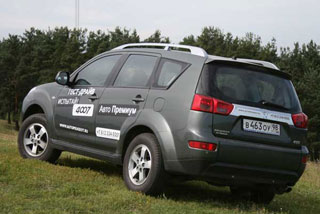 The steering wheel from the first degrees of rotation causes a quick change in the trajectory and with small corners of rotation is saturated with reactive effort.
The steering wheel from the first degrees of rotation causes a quick change in the trajectory and with small corners of rotation is saturated with reactive effort. Total
Who would have thought that the Peugeot crossover would be the only car that provides the opportunity to choose a drive (front, full, full with a blocked center)?
Given the 210 mm clearance, the two zeros turned out to be, for today, the most adapted to the off -road car. And with high smoothness with intelligible controllability of the 4007th, it is also suitable for the city. I can’t even believe that this is all about one car
Technical characteristics of Peugeot 4007
(manufacturer data)
Dimensions, mm (DHSHHV)
4 635 x 1 805 x 1 670-1 715
Equipped mass, kg
1 790
Road clearance, mm
210
Trunk volume, l (min)
510
Engine volume and power, l (l.
2.4 (170/6 000)
Maximum torque, Nm at rpm
232/4 100
Acceleration to 100 km/h, with
9.6
Maximum speed, km/h
191
Fuel consumption (city/highway), l/100 km
12.6/7.6
Prices
The most affordable Peugeot 4007 costs from 963,500 rubles. This includes: 2.4-Lture gasoline engine, 5 manual transmission, 6 airbags, ABS, ESP, Cruise control, steering wheel amplifier, adjusting the steering column in height, MP3-magnet with 6 speakers, adjusting the driver's seat in height. A similar equipment with a variator (automatic transmission) costs 977,500 rubles. For the maximum version with gasoline 2.4 Premium Pack will have to lay out 1,084,000 rubles, and for the minimum, but with a 2.2-liter turbodiesel from 1,004,000 rubles.
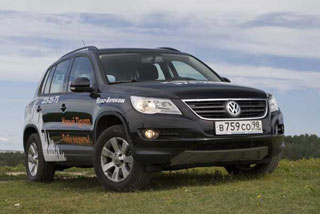 Volkswagen Tiguan
Volkswagen Tiguan Outside
From the side, Tiguan is Touareg, reduced in proportions. Consequently, the crossover looks discreet, but the massive polished VW shild on the radiator grill stopped calling for associations with something affordable and folk. Rather, on the contrary.
The youngest is fulfilled in full accordance with the proprietary style of Volkswagen, starting with the form of headlights and lanterns, and ending with silhouette and general style. From some angles they can even be confused
But, if desired, Tiguan is easy to give individuality before the purchase: you can choose the future appearance of the crossover yourself. Tiguan is available in the trimations of Track & Field and Sport & Style, which endow it with either low and stylish or off -road body kit. In addition, in the second option, the car will also receive an off-rock package of useful electronics
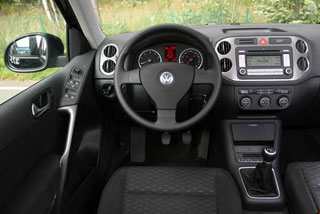 Inside
Inside The crossover salon is fulfilled in full accordance with Volkswagen: all the same order, ergonomics and family identity. The view from the inside is absolutely the same as in Golf and Touran. It is logical that the quality of the parts is appropriate; At the height, the readability of the devices and the range of driver's adjustments.
Not at Tiguan’s hand only a tight salon, a common-gray (traditionally) color scheme and a steering wheel, devoid of at least music. However, Volkswagen promise to fix this in the near future.
Tiguan is assembled in Russia in the Kaluga region. It is clear that the German quality of assembly cannot talk. But maybe about Russian: the details are fitted no worse than Western analogues! Recall that in February, the wheels of the wheels met Tiguan in Finland (No. 125 for March 2008), and they can safely say that there is a difference as an assembly ...
And it was the Russian car that left the best impression! German Tiguan creaked somewhere behind, although it could be an age that car ran more than 5,000 km ...
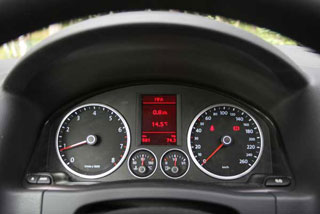 In move
In move Under the hood of Tiguan is a 1.4-liter 150-horsepower TSI engine forced modification of a 140-horsepower twice golf and Touran. The drive, by default, is the front, but in the case of slipping one of the front wheels, the modified Haldex coupon quickly throws the required amount of torque to the rear axle.
The gearbox is still without options: manual, six -speed. There are no complaints about the handle: it works clearly and debugged, as befits a German car, but the machine is needed. If only because every minute to make the path from the first to the sixth program on Tiguan is a doubt pleasure.
The engine is what you need! The motor smoothly and briskly accelerates and picks up from any revolutions. The crossover is obediently and confidently controlled, even despite the faint force on the steering wheel familiar to the brand. Tiguan is stable in turns, but I'm sure of the acceleration.
Not a good soundproofing, coupled with unsuccessful tires, makes Tiguan an incredibly quiet and acoustically comfortable car.
The disadvantages of Tiguan crawled along with the end of the flat asphalt road. A hard body, short-flowing suspension and elastic-fierce shock absorbers forced to reset speed to a minimum when pits and potholes begin to grow frighteningly in size. Blows and shocking the body is an ordinary shift on off -road. In addition, a short stroke of shock absorbers often leads to breakdowns. So, the similarity with Touareg turned out to be exclusively external
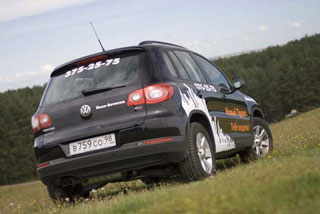 Total
Total The seriousness of the off-road arsenal and the very possibility of choosing equipment the idea is a successful, but extreme-unique version of Track & Field (set of a test car) loses 4007th in the clearance and in comfort on off-road.
As for the city, here VW enters the leading and overclocking leaders. And if we wait for the machine gun, Tiguan can become one of the most attractive city crossovers.
Technical characteristics of Volkswagen Tiguan
(manufacturer data)
Dimensions, mm (DHSHHV)
4 427 x 1 809 x 1 686
Equipped mass, kg
1 546
Road clearance, mm
200
Trunk volume, l (min-max)
470
Engine volume and power, l (l.
1.4 (150/5 800)
Maximum torque, Nm at rpm
240/1 750-4 000
Acceleration to 100 km/h, with
9.6
Maximum speed, km/h
192
Fuel consumption (city/highway), l/100 km
10.6/7.0
Prices
Tiguan is available in three trim levels, the most affordable of which Trend & Fun costs from 849,999 rubles. It includes: a 1.4-liter 150-horsepower engine with 6 MKPP, 6 airbags, many electronic auxiliary systems (ABS, EBV, HBA, EDS, ASR, MSR, DSR, ESP), steering electric power, adjusting the driver's seat, adjustable in height And the depths of the steering column, cruise control, climate control, radio with MP3. A car with the same engine, but in the trim levels, Track & Field and Sport & Style costs from 904,000 rubles. For a 2.0-liter 170-line gasoline engine, you will have to lay out at least 1,053,550 rubles.
Text: Alexander Korobchenko Alexander Mikhailov,
Photo: Roman Ostanin
A source: Wheel magazine [September 2008]


